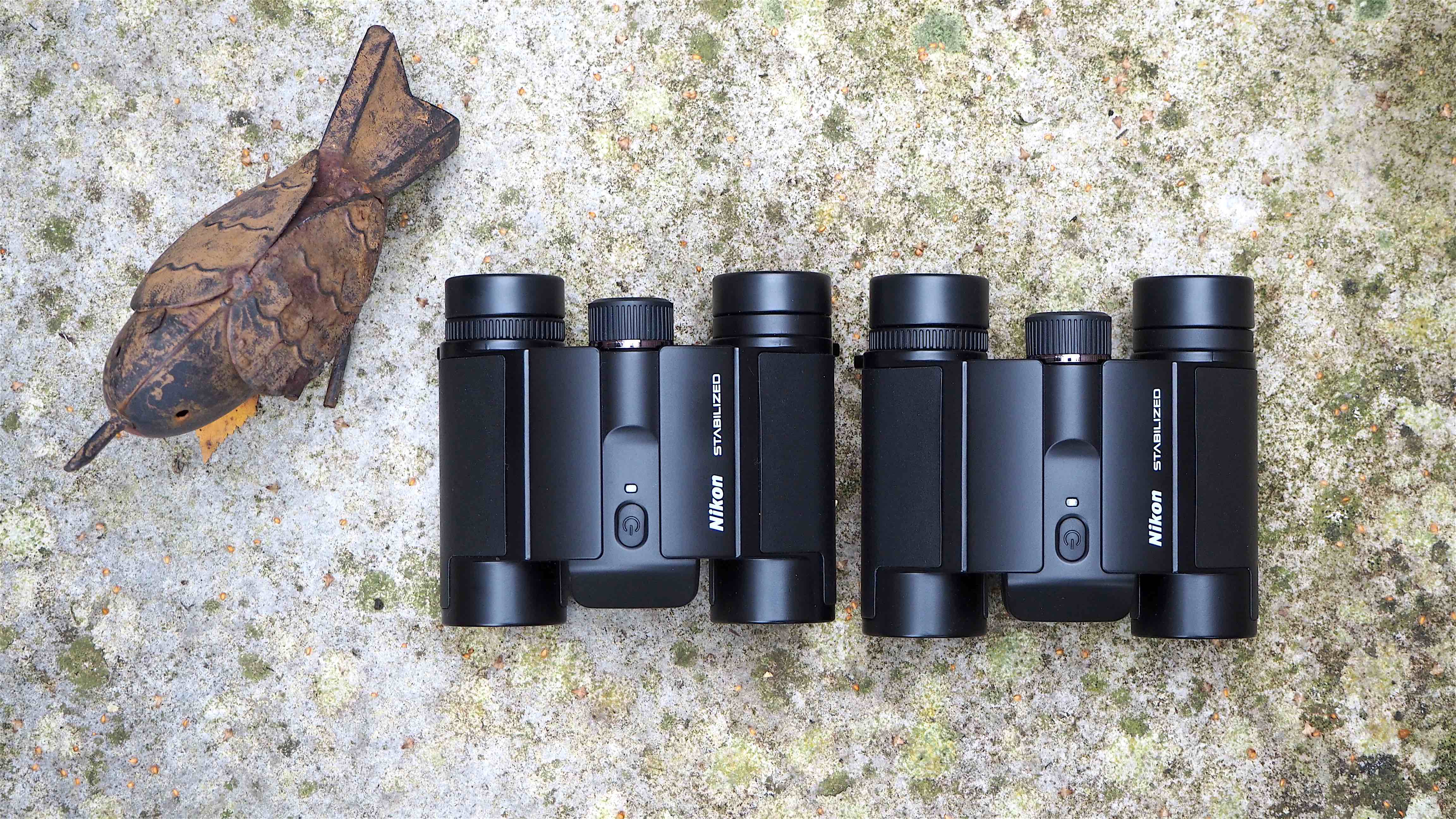Digital Camera World Verdict
With the only major difference between the Nikon Stabilized 12x25 S and the 10x25 S being a barely noticeable difference in magnification, at last, we have a pair of alternatives to possibly crack Canon’s years-long dominance of the IS-equipped binocular market. Counter-intuitively, the construction of the lower magnification 10x25 S is just a tad longer than the 12x25 S at 103mm rather than 100mm in length, and also weighs a little more at 405g, as opposed to the 12x’s 395g without battery. That said the difference is negligible for sure and both will readily fit into the exact same jacket pocket. Stylish looking as well as convenient to transport, the impressive fact is they’re not much bigger than a standard non-stabilized binocular of similar core specification. Build quality is as solid as we’d expect from Nikon and the compact size means we’re more likely to take them out and about with us than chunkier image-stabilized rivals from Canon or Fujifilm.
Pros
- +
Built in stabilisation makes for a steadier more comfortable view, more pronounced and more useful the higher the magnification
- +
Powered by two convenient to replace/source AAs
- +
Compact size and weight makes this eminently portable and conveniently so
Cons
- -
25mm objective lens size is fairly modest/not the brightest
- -
Premium price tag still puts these out of reach of many
- -
Plastic cover and latch for batteries not of same rock-solid build quality as the rest of the binocular
- -
No screw thread for attaching to a travel or table top sized tripod if desired
Why you can trust Digital Camera World
Why would anyone want a pair of stabilized binoculars? Well, if you’ve ever tried to hold a binocular with a higher magnification than, say, 8x steady without the aid of a tripod, you’ve probably encountered the effects of hand wobble; namely an eyepiece image that appears to judder or dance about, as the effects of any hand tremor on behalf of the user are themselves magnified.
If, by contrast, you’ve tried an image-stabilized binocular then you’ll have witnessed that shaky image nigh-instantly transformed into a smooth and steady one, as if we were viewing subjects at a distance of just a few feet away, rather than hundreds of meters.
In recent years, if we’ve been shopping for a pair of high-quality image-stabilized binoculars then pretty much only Canon had such an offering. With little or no competition, that meant a premium price tag to match. And because of the requirement for an onboard image stabilization mechanism and battery to power it, Canon’s IS-equipped devices have inevitably been chunkier in build than a standard non-stabilized binocular.
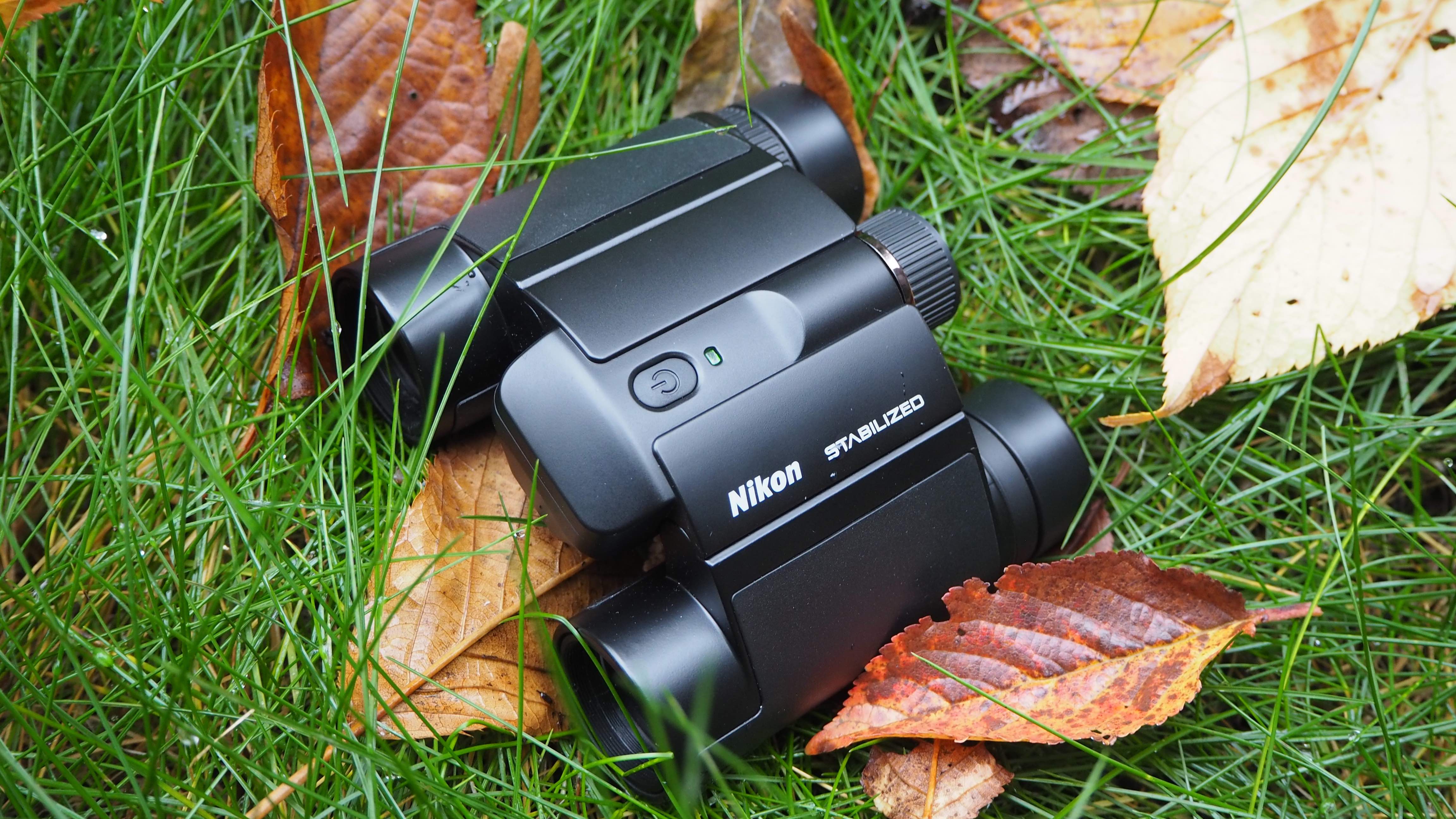
Now Nikon, having taken its foot off the gas in this category in recent years, is stepping back into the frame with a pair of Canon-baiting alternatives. Its new 12x25 S and 10x25 S are nigh identical save for a barely noticeable size difference and slightly differing magnifications in each case. And our first impression is that these are, impressively, a lot less bulky overall than its closest competitor’s devices. In fact, they’re pretty much the same size we’d expect of a regular non-stabilized binocular.
So, its own premium price tag aside, has Nikon cracked it? Does it now offer wobble-free, easy-on-the-eye viewing of subjects at a distance, without obvious compromise elsewhere? Read on to find out…
Nikon Stabilized 12x25 S and 10x25 S: Specifications
| Magnification | 10x / 12x |
| Objective lens diameter | 25mm |
| Field of view at 1000 metres | 79 metres (Stabilized 12x25 S) or 94 metres (Stabilized 10x25 S) |
| Closest focusing distance | 3 metres / 9.8 feet |
| Eye relief | 12.3mm (Stabilized 12x25 S) or 14mm (Stabilized 10x25 S) |
| Dimensions | 100x89x65mm or 3.9x3.5x2.6 inches when folded (Stabilized 12x25 S); 103x89x65mm or 4.1x3.5x2.6 inches when folded (Stabilized 10x25 S) |
| Weight without battery | 395g (Stabilized 12x25 S) or 405g (Stabilized 10x25 S) |
Nikon Stabilized 12x25 S and 10x25 S: Key Features
Leaving aside the Nikons’ stabilized ‘S’ factor for a moment, as with any binocular, the most important feature here is slap bang in the name of the units themselves, namely 10x25 or 12x25. Most casual observers are aware this denotes a 10x or 12x magnification wedded to an objective lens 25mm in diameter. The usual trade-off is that the higher the magnification and the bigger the objective lens, then typically the physically larger and heavier the binocular is.
So the impression given here is that Nikon has kept a modest 25mm lens size to maintain compact proportions overall. We’re already adding weight and bulk courtesy of the 2x AA batteries required to power the image stabilization/vibration reduction feature of each.
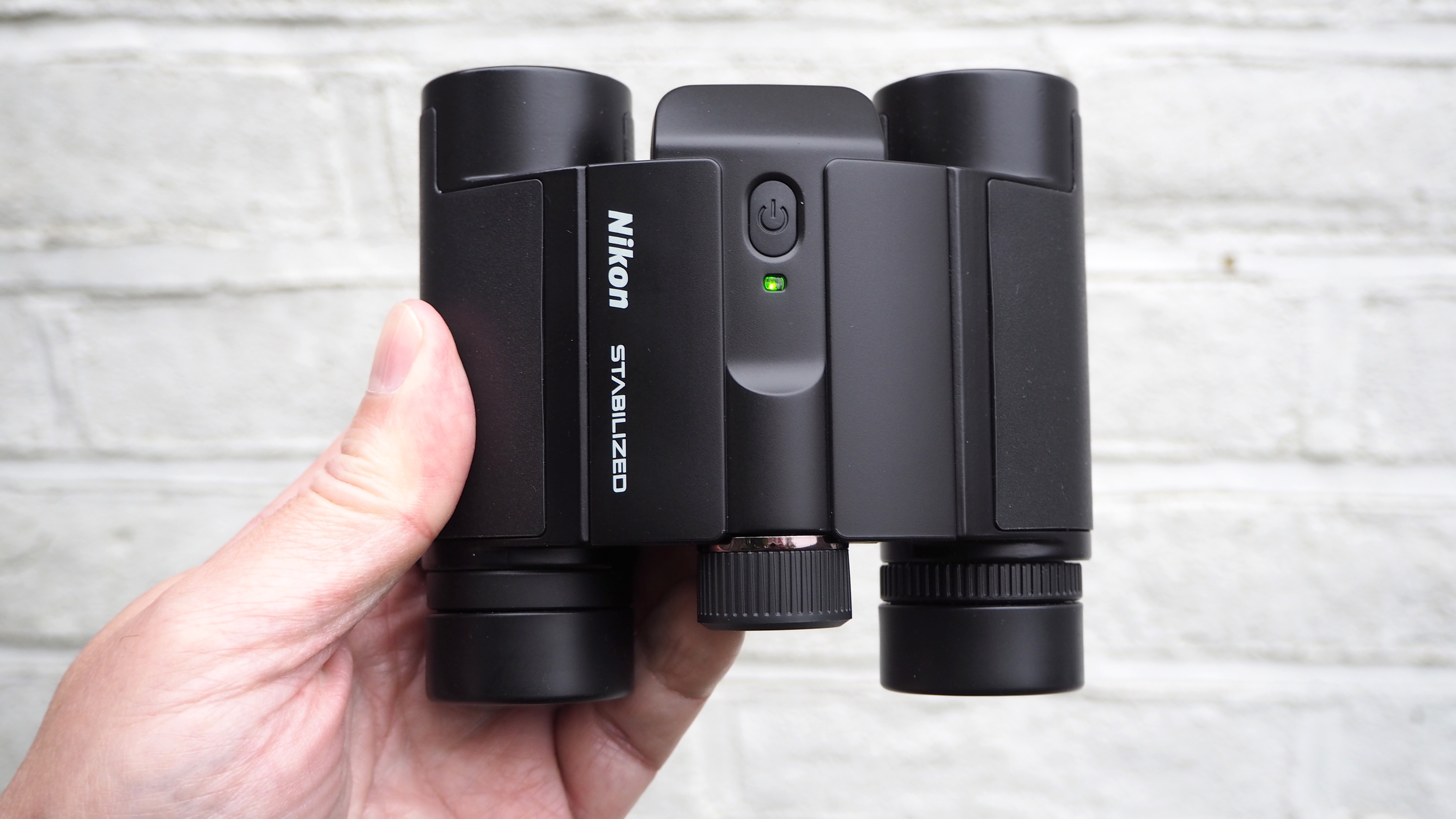
The battery life of both 10x25 and 12x25 models is said to be good for up to 12 hours of use, but in practice, we’re highly unlikely to be using the feature non-stop all day long. It’s more likely that if we’re traveling abroad for a week’s holiday, with casual daily usage when sightseeing, we’ll have sufficient juice to see us through.
As it’s Nikon’s intention to provide image stabilization without the bulk normally associated with binocular shoehorning in such a feature, there aren’t quite all the bells and whistles we might find elsewhere. For example, there is no screw thread provided here should anyone want to add a tripod for hands-free use. So with both Nikon binoculars, it’s all about hand-held operation.
Nikon Stabilized 12x25 S and 10x25 S: Design & Handling
As mentioned in our intro, with a relatively slim and compact construction, the roof prism type Nikon 10x25 S and 12x25 S are not that dissimilar in size to a regular non-stabilized analog binocular, and one that doesn’t need to have a pair of AA batteries on board to power it.
Along with the expected anti-reflective, multi-coated lenses, a central folding mechanism features here. This allows for the distance between the eyepieces to be manually adjusted to provide the best fit with our own, as well as the unit to be made as small and compact as possible for transportation when not in use. Both 10x25 and 12x25 options will fit in the pocket of a jacket or coat, though they are a little weighty, if not prohibitively so, because of the integral anti-shake mechanism, batteries, and solid-feel construction overall.
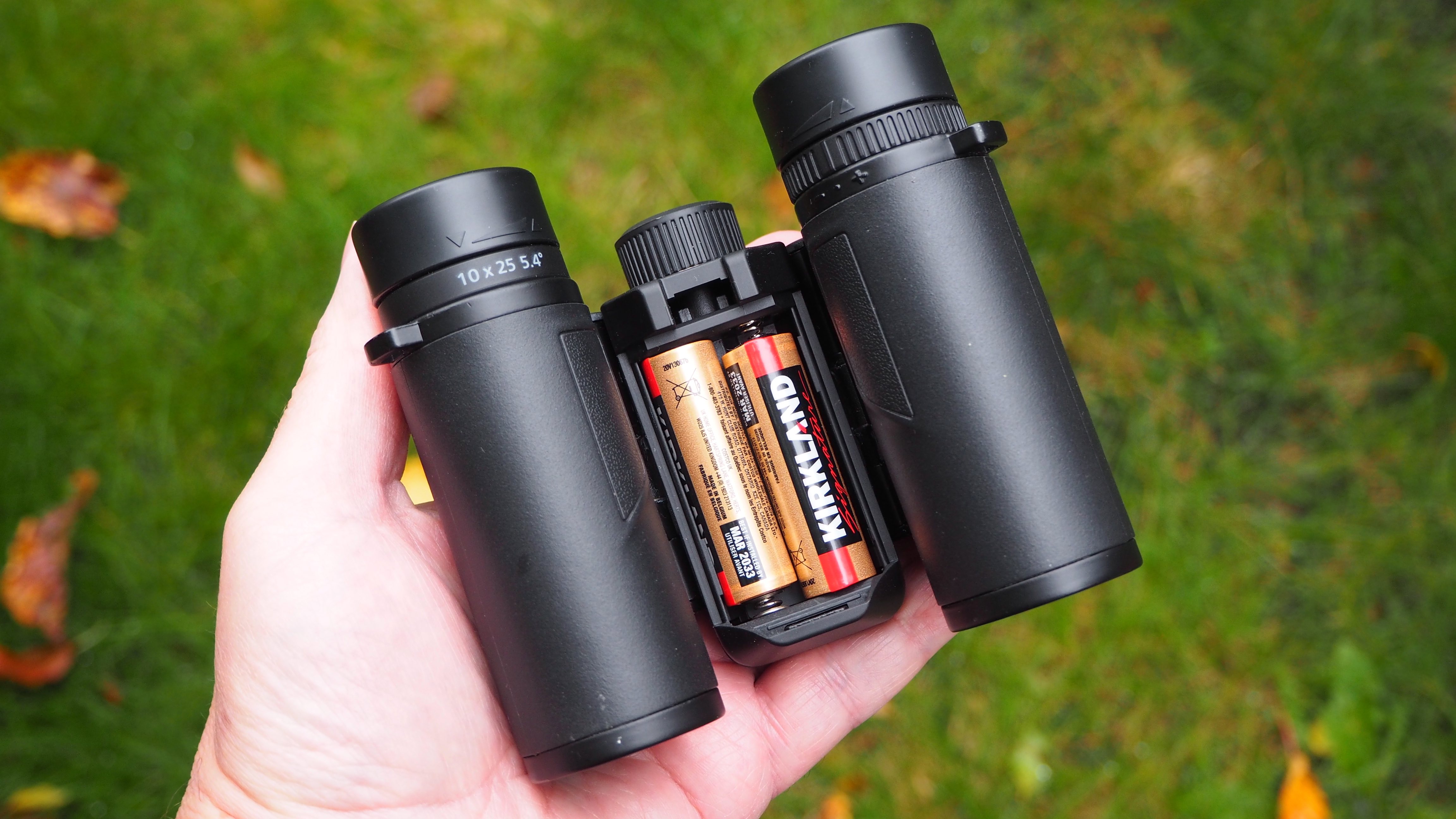
Slip-on plastic cups protect the eyepieces when not in use, while a neck strap is also provided out of the box. Turn and slide rubber eyecups likewise feature, which can be adjusted for our personal viewing comfort. The knurled focus ring is also located directly between the eyepieces, where it can be adjusted between the forefinger and thumb when the device is held up to our face.
Overall, the level of construction is of the high standard we’d expect from Nikon. Both binocular variants feel rock solid when held in the palm and are of obviously good quality. If we’re picking holes however a potential Achilles’ heel is the plastic cover and latch for the battery compartment at the base of each unit, which in being plastic-y isn’t of the same quality as the rest. As the plastic here needs to be flexed to insert or retrieve batteries we can imagine this becoming weakened over time.
Nikon Stabilized 12x25 S and 10x25 S: Performance
Nikon claims the that advantage of having built-in stabilization here, and ultimately us paying a premium for the feature, is that it can counteract the effects of any hand tremor by up to a sizeable 80%.
Of course, given the binoculars already have a decent weight and solidity to them despite the diminutive proportions, it’s perfectly possible to achieve a comfortable viewing experience without the built-in stabilization being activated, especially if resting the extended eyepieces against our eye sockets or the rim of a pair of spectacles.
However, if we hit the power button situated atop the device, located at the midpoint between the lenses, then stabilization kicks in so rapidly the contrast is both marked and surprising. What was subject to a little visible tremor before, even if not distractingly so, now immediately becomes smoothed out. Subjects appear to glide as if on ice as you pan with them, rather than looking ever so slightly jittery.
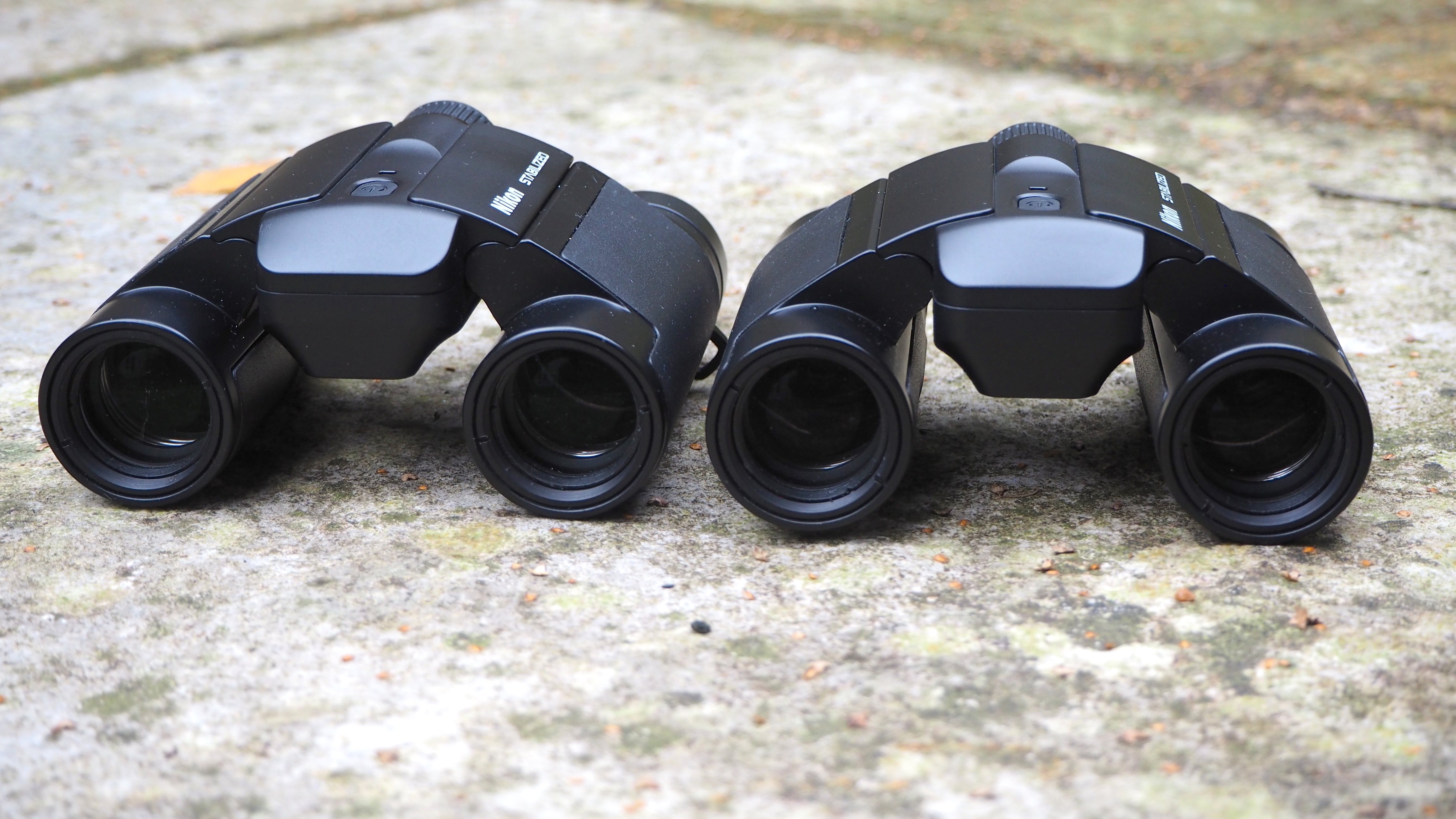
Operational peace of mind is provided by an automatic power-off function that kicks in after 60 minutes if we do accidentally leave the stabilized function on while we’re not using the binoculars. However, a green light on the top does illuminate to indicate the stabilization is active.
So yes, it does work and works well. Now the question that needs to be asked is will we be using the binoculars often enough, as well as for long, extended periods of time, to be able to justify the spend here?
In use, the field of view provided is relatively modest. Essentially if you want a slightly wider view to help keep your subject in the frame go for the 10x25, or if you prefer a marginally closer view, instead sacrifice that aspect and go for the 12x25.
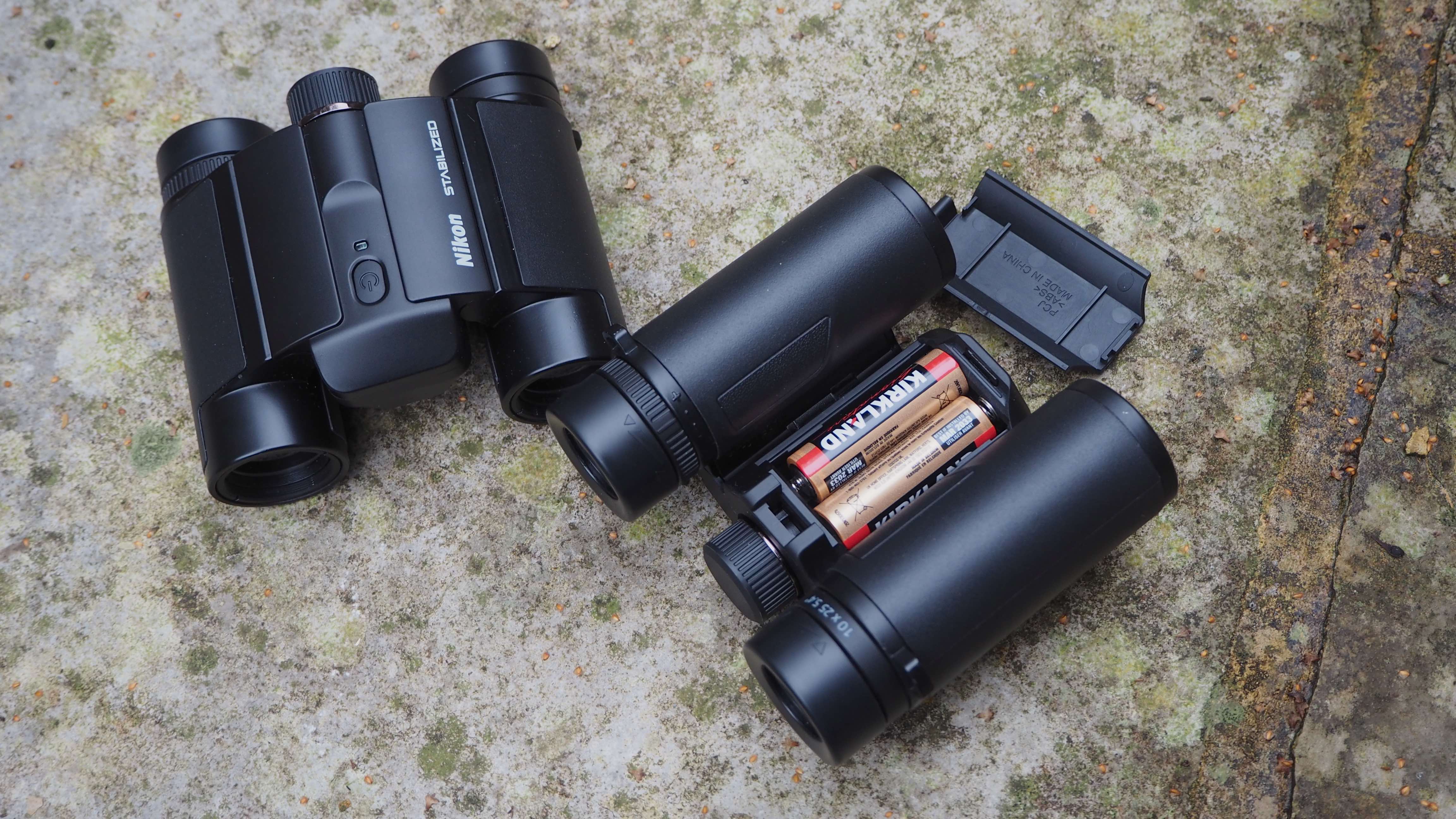
We found it best to first pinpoint our subjects with our own eyes before raising the binocular to get a more detailed, closer view. Sharpness is impressive and even on a dull, overcast day, we were able to achieve plenty of clarity and detail, with any occasional instances of purple fringing kept well under control.
To the untrained eye, there’s not that much of a discernable difference in terms of field or view, or sharpness when switching from one of these Nikon binoculars to the other. And certainly the higher magnification 12x bino doesn’t seem any shakier given its additional reach, whether used without stabilization or with it deployed. You might therefore use price to determine which one of the Nikons you choose, but here too the difference is so negligible that doesn’t really help in selecting one over the other.
Nikon Stabilized 12x25 S and 10x25 S: Verdict
A steady, clear field of view when we look through our binoculars so we can fully focus on the intended subject – whether music gigs, wildlife, or sporting events – is all any of us wants. Here Nikon provides this to such a degree of competency that, when panning with the device and stabilization is activated, subjects appear to glide, as smoothly rendered as if they were performing on ice.
The construction of both these binoculars also impresses us for the most part, suggesting the possibility of an initial sizeable investment will potentially be rewarded with years of continued use. The relatively compact size and weight here make them pocket-friendly too. We’re more likely to take the Nikon Stabilized 12x25 S and 10x25 S binoculars out with us on a ramble, field trip, or sightseeing expedition than bulkier alternatives from chief rival Canon. But ultimately increased competition in the stabilized binocular market is what Nikon is now offering, which is good news for all of us.
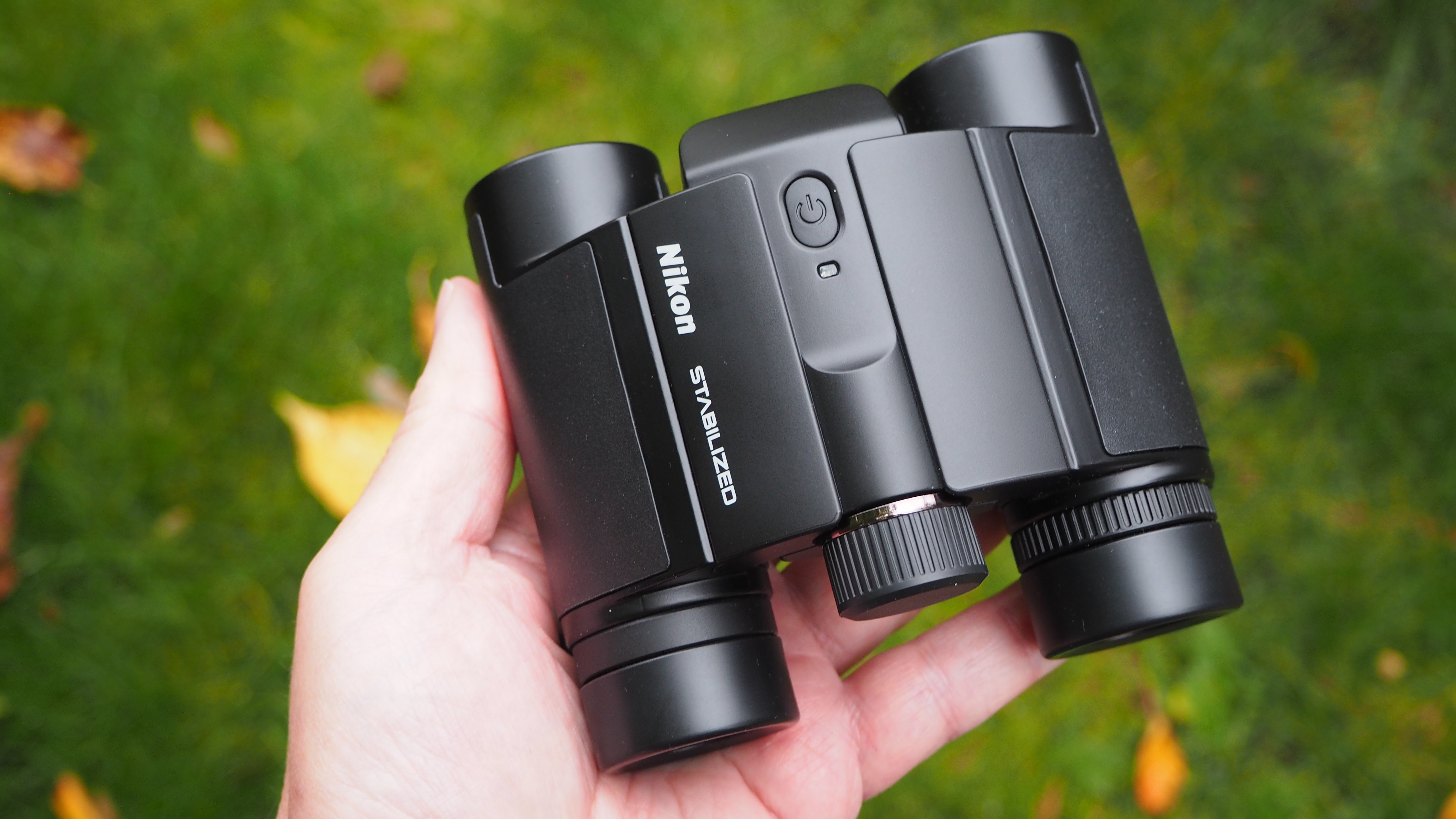
Alternatives
As we mentioned in our introduction, Canon has long ruled the roost when it comes to image-stabilized binoculars for the enthusiast and professional – largely unchallenged by its closest historical rival until now.
One of the nearest pretenders to the Nikon Stabilized 12x25 S and 10x25 S binoculars is the Canon 12x36 IS III. While the magnification is similar the Canon benefits from a larger objective lens to go with it. The bigger the lens, the more light gets in and so, as day follows night, the clearer the image in the eyepiece should be. Like both Nikons this Canon model is also powered by two AAs. But it’s weightier at 660g without batteries, as well as being chunkier, albeit not prohibitively so. Dimensions are still manageable 5x6.9x2.8-inches or 127x70x174mm for this rubber-armored Canon.
If the plan is to be out in all weathers, or if you’re a serious birder and ‘power user’, then it could also be worth taking a look at Canon’s high-end 10x42L IS WP flagship binocular. This likewise offers body integral anti-shake but has that bonus ‘WP’ at the end of the model name to indicate protection in the wet and the wild. At the other end of the scale for everyday use it’s also worth checking out current pricing on the bulbous 8x20 IS and 10x20 IS models from Canon. As is the case with Nikon’s latest, the benefit of body integral anti-shake is however less pronounced/effective on these lower magnification models.
Leaving Canon aside, a more recent option for image-stabilized binoculars comes with Fujifilm’s Fujinon Techno-Stabi TS16x28WP. We described this water-proof option as good-looking, well-built, and conveniently portable in our review. That said, we also had minor gripes about a narrow-ish field of view – because of the higher magnification – hindering us if we were trying to track wildlife, and we didn’t feel they were quite as bright as some we’d tested.
Gavin has over 30 years’ experience of writing about photography and television. He is currently the editor of British Photographic Industry News, and previously served as editor of Which Digital Camera and deputy editor of Total Digital Photography.
He has also written for a wide range of publications including T3, BBC Focus, Empire, NME, Radio Times, MacWorld, Computer Active, What Digital Camera and the Rough Guide books.
With his wealth of knowledge, Gavin is well placed to recognize great camera deals and recommend the best products in Digital Camera World’s buying guides. He also writes on a number of specialist subjects including binoculars and monoculars, spotting scopes, microscopes, trail cameras, action cameras, body cameras, filters and cameras straps.
You must confirm your public display name before commenting
Please logout and then login again, you will then be prompted to enter your display name.
